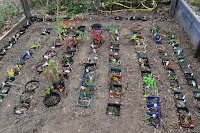Columbine Love

Columbine is a lovely flower to see in sun or part-shade garden spots. The bell-shaped flowers are a gorgeous red-hot-pink with yellow center and anthers. Mary Ann King at Pine Ridge Gardens said in Plant of the Week - " Eastern columbine is native to Arkansas and all states from the Midwest to the eastern shores with the exception of Louisiana. Zones 3-9. There are several misconceptions surrounding this lovely native. Most folks think it is delicate – and I agree that it looks fragile. But let me tell you it is one TOUGH plant. It will grow in the full sun, out between two rocks, or it will grow in the shade or anywhere in between. I’ve seen it growing out of boulders where it has almost no soil. It is certainly drought tolerant. I think it probably wouldn’t like soils that are too wet. Hummingbirds adore it. Bumblebees as well. Grows from 1 to 3’ tall. After flower...












